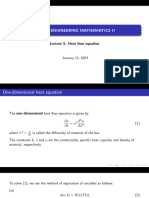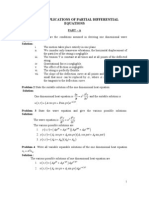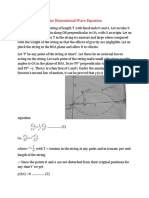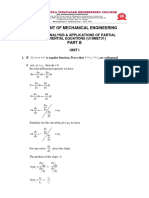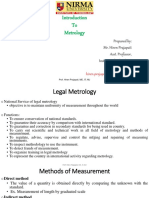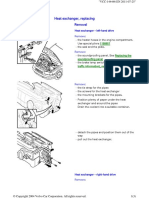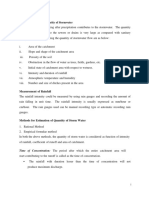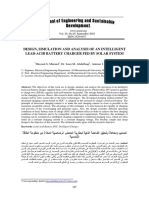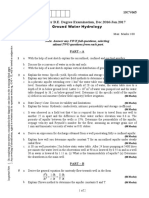Dhanalakshmi College of Engineering, Chennai.
2009 One dimensional Wave equation
Zero initial velocity
Pre Work: 1 The wave equation is The solution is
y( x , t ) = ( A cos px + B sin px ) ( C cos pat + D sin pat ) ( 1 )
2 y 2 y = a2 2 x t 2
The boundary conditions for zero initial velocity i) ii) iii)
y(0, t ) = 0 for all t
y( , t ) = 0 for all t
y( x , 0) =0 t initial velocity is zero
iv) y( x , 0) = f ( x ) for all x
(To be given)
Applying boundary condition i) in ( 1 ) by putting x = 0
y(0, t ) = ( A + 0 ) ( C cos pat + D sin pat ) = 0
A ( C cos pat + D sin pat ) = 0
A=0
C cos pat + D sin pat 0
Substituting in ( 1 ), we get
y( x , t ) = B sin px ( C cos pat + D sin pat ) ..( 2 )
Applying boundary condition ii) in ( 2 ) by putting x =
y( , t ) = B sin p ( C cos pat + D sin pat ) = 0
sin p = 0 B 0 & C cos pat + D sin pat 0
Page 1
Prepared by C.Ganesan, M.Sc., M.Phil., (Ph:9841168917)
�Dhanalakshmi College of Engineering, Chennai. 2009
sin p = sin n
p= n sin n = 0
Substituting in ( 2 ), we get
n x n at n at + D sin C cos ..( 3 )
y( x , t ) = B sin
To apply condition iii) , diff. partially w.r.t t
n x n at n a n at n a y ( x , t ) . . = B sin + D cos C sin t
Now applying condition iii) in above by putting t = 0 , we get.
n x n a y( x , 0) = B sin 0 + D(1) =0 t
BD n a sin n x =0 n x
D=0
B 0 & sin
Substituting in ( 3 ), we get
y( x , t ) = BC sin n x .cos n at
.( 4 ) ( taking BC = C n )
By the Most general solution,
y( x , t ) = C n sin
n =1
n x
.cos
n at
..( 5 )
To find C n applying condition iv) in above by putting t = 0 , we get.
y ( x , 0) = C n sin
n =1
n x
.1 = f ( x )
Prepared by C.Ganesan, M.Sc., M.Phil., (Ph:9841168917)
Page 2
�Dhanalakshmi College of Engineering, Chennai. 2009
C
n =1
sin
n x
= f ( x)
( To find Cn , If f(x) is algebric we can use Fourier series and if f(x) is trigonometric then we can use the method of comparing the co-efficients. Sub. Cn value in (5) equation. )
Non - Zero initial velocity
Pre Work: 2
2 2 y 2 y The wave equation is 2 = a x 2 t
The solution is
y( x , t ) = ( A cos px + B sin px ) ( C cos pat + D sin pat ) ( 1 )
The boundary conditions for non - zero initial velocity i) ii)
y(0, t ) = 0 for all t
y( , t ) = 0 for all t
iii) y( x , 0) = 0 for all x iv)
y( x , 0) = f ( x) t
(To be given)
Applying boundary condition i) in ( 1 ) by putting x = 0
y(0, t ) = ( A + 0 ) ( C cos pat + D sin pat ) = 0 A ( C cos pat + D sin pat ) = 0
A=0
C cos pat + D sin pat 0
Substituting in ( 1 ), we get
y( x , t ) = B sin px ( C cos pat + D sin pat ) ..( 2 )
Prepared by C.Ganesan, M.Sc., M.Phil., (Ph:9841168917)
Page 3
�Dhanalakshmi College of Engineering, Chennai. 2009
Applying boundary condition ii) in ( 2 ) by putting x =
y( , t ) = B sin p ( C cos pat + D sin pat ) = 0
sin p = 0
sin p = sin n
p= n
B 0 & C cos pat + D sin pat 0
sin n = 0
Substituting in ( 2 ), we get
n x n at n at + D sin C cos ..( 3 )
y( x , t ) = B sin
Applying boundary condition iii) in ( 3 ) by putting t = 0
y( x , 0) = B sin n x
( C .1 + 0 ) = 0
BC sin
n x
=0
C =0
B 0 & sin n x 0
Substituting in ( 3 ), we get
y( x , t ) = BD sin n x .sin n at
.( 4) ( taking BD = C n )
By the Most general solution,
y( x , t ) = C n sin
n =1
n x
.sin
n at
....( 5 )
To apply condition iv) , diff. partially w.r.t t
n x n at n a y ( x , t ) .cos . = C n sin t n =1
Now applying condition iv) in above by putting t = 0 , we get. Prepared by C.Ganesan, M.Sc., M.Phil., (Ph:9841168917) Page 4
�Dhanalakshmi College of Engineering, Chennai. 2009
n x n a y( x , 0) .1. = C n sin = f ( x) t n =1
C
n =1
n a
n
sin
n x
= f ( x)
( To find Cn , If f(x) is algebric we can use Fourier series and if f(x) is trigonometric then we can use the method of comparing the co-efficients. )
One dimensional Heat Flow equation
Zero Boundary conditions (Temperature at both ends zero)
Pre Work: 3 The one dimensional heat flow equation is The solution is u( x , t ) = ( A cos px + B sin px ) Ce The boundary conditions i)
2 2
u 2u =2 2 x t
p t
( 1 )
u(0, t ) = 0 for all t
ii) u( , t ) = 0 iii) u( x , 0) = f ( x ) ( To be given )
Applying boundary condition i) in ( 1 ) by putting x = 0
u(0, t ) = ( A.1 + 0 ) Ce
2
p2 t
=0
ACe
p2 t
=0 Ce
2
A=0
p2 t
Substituting in ( 1 ), we get
Prepared by C.Ganesan, M.Sc., M.Phil., (Ph:9841168917)
Page 5
�Dhanalakshmi College of Engineering, Chennai. 2009
u( x , t ) = B sin px .Ce
2
p2 t
..( 2 )
Applying boundary condition ii) in ( 2 ) by putting x =
u( , t ) = B sin p .Ce
sin p = 0
sin p = sin n
p= n
2 2
p t
=0
2
B 0 & Ce
p2 t
sin n = 0
Substituting in ( 2 ), we get
n x
n2 2
2
u( x , t ) = BC sin
..( 3 )
take BD = C n By the Most general solution,
u( x , t ) = C n sin
n =1
n x
n 2 2
2
..( 4 )
Now applying condition iii) in above by putting t = 0 , we get.
u( x , 0) = C n sin
n =1
n x
e0 = f ( x)
C
n =1
sin
n x
= f ( x)
( To find Cn , If f(x) is algebric we can use Fourier series and if f(x) is trigonometric then we can use the method of comparing the co-efficient. )
Prepared by C.Ganesan, M.Sc., M.Phil., (Ph:9841168917)
Page 6
�Dhanalakshmi College of Engineering, Chennai. 2009
Problems under steady state conditions (Temperature at one end zero and the other end non zero)
Pre Work: 4 General Question: A rod of length is kept at temperature 0C and KC at the ends A and B until steady state condition prevail. Then the temperature at the end B is suddenly reduced to 0C while that at A is maintained so. Find the temperature distribution along the rod. Solution: Under the steady state condition,
u =0 t
From the one dimensional heat equation, we get
u( x ) = ax + b ..( a )
The boundary conditions i)
u(0) = 0
ii) u( ) = K Applying boundary condition i) in ( a ) by putting x = 0
u(0) = 0 + b = 0
b=0
Applying boundary condition ii) in ( a ) by putting x =
u( ) = a + b = K
a +0= K K a= Sub. a and b values are in ( a ), we get. u( x ) = Kx
(Now this can be taken as f(x))
Now do the Pre Work: 3
Prepared by C.Ganesan, M.Sc., M.Phil., (Ph:9841168917) Page 7














